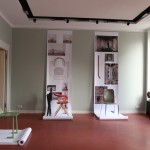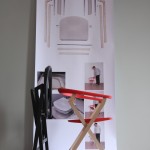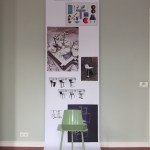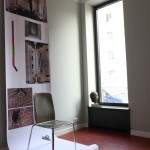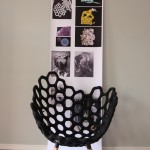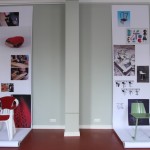Werkbund Galerie Berlin: Zwischen den Stühlen – Möglichkeitsmodelle als Sitzgelegenheiten
As we noted in our review of the book “WEGNER – Just one good chair”, Hans J. Wegner spent a large proportion of his career seeking to perfect and improve his chair designs.
“If only you could design just one good chair in your life . . .”, he mused in 1952, “But you simply cannot”
Similarly for Egon Eiermann the “Chair of his Life” was always the next chair design.
While Ludwig Mies van der Rohe was famously of the opinion that designing a chair was more complicated than building a skyscraper.
Despite its intrinsic simplicity the chair has always been one of the most active areas in furniture design. Largely because the chair is so intrinsically simple. How do you improve what is so simple?
Until Wednesday April 30th the Werkbund Galerie Berlin is presenting “Zwischen den Stühlen – Möglichkeitsmodelle als Sitzgelegenheiten” an exhibition devoted to contemporary experimental chair design, and an exhibition which delightfully explains why it is important that designers keep experimenting with chair designs.
Curated by Prof. Axel Kufus Zwischen den Stühlen presents 5 experimental chair concepts developed by Universität der Künste, UdK, Berlin students, projects that show the variety of options in chair design and how chair design can be extrapolated into further areas of product design.
The Hydra chair project by Jörg Höltje, for example, is created using high-pressure tube hydroforming, a relatively low-cost method of producing stable, lightweight metal objects, and a process applied to furniture design for the first time with Hydra, or Fragment by David Geckeler, an aluminium sand cast chair in which the system through which the molten aluminium is fed into the cast becomes part of the final structure; namely the legs.
Schlanzen by Max Schäth, Fynn Freyschmidt & Pascal Hien originated in context of the 2011 UdK research project “Exploring Alcantara”, organised in cooperation with the eponymous Italian textile producer with the aim of not only finding potential new uses for the Alcantara textile but also of changing perceptions on and off the Alcantara textile. Max Schäth, Fynn Freyschmidt & Pascal Hien initially used a piece of Alcantara, and a piece of Alcantara alone, to cushion a stone – no, honest – before applying the same process to cushion a plastic garden chair, again without the need for any upholstery or other padding. Just Alcantara.
An alternative approach to using textiles to create furniture was explored by Joscha Brose for his 2009 diploma project, Making Furniture With a Textile Mould. Which is exactly what Joscha did, the end result being a chair formed from welded textile filled with polyurethane foam. A production process that not only dispenses with current production technologies but allows fabric furniture to be created with fewer resources, and less waste
The newest work on show is Robert Fehse’s foldable chair Stand By. Created from wood and injection moulded plastic the clou with Stand By is the mechanism that allows it to be folded with one hand. And the fact that once folded it stands securely and unaided. Simple, simple features that can make all the difference when trying to re-organise a room or quickly tidy up.
In addition to the chairs, a short video presentation explains each project in a little more detail.
Quite aside from being a nice introduction to five interesting projects Zwischen den Stühlen is also a nice reminder that design students do actually do some very useful work in the course of their studies; especially when those studies take place in context of an institute such as the UdK Berlin which actively encourages and supports experimentation.
Zwischen den Stühlen – Möglichkeitsmodelle als Sitzgelegenheiten can be viewed at the Werkbund Galerie, Goethestraße 13, 10623, Berlin until Wednesday April 30th. Entry is free.
Full details, including opening times, can be found at www.werkbund-berlin.de
- Zwischen den Stühlen Möglichkeitsmodelle als Sitzgelegenheiten at Werkbund Galerie Berlin
- Stand By by Robert Fehse, as seen at Zwischen den Stühlen Möglichkeitsmodelle als Sitzgelegenheiten, Werkbund Galerie Berlin
- Fragment by David Geckeler, as seen at Zwischen den Stühlen Möglichkeitsmodelle als Sitzgelegenheiten, Werkbund Galerie Berlin
- Hydra by Jörg Höltje, as seen at Zwischen den Stühlen Möglichkeitsmodelle als Sitzgelegenheiten, Werkbund Galerie Berlin
- Making Furniture With a Textile Mould by Joscha Brose, as seen at Zwischen den Stühlen Möglichkeitsmodelle als Sitzgelegenheiten, Werkbund Galerie Berlin
- Schlanzen by Max Schäth, Fynn Freyschmidt & Pascal Hien and Fragment by David Geckeler, as seen at Zwischen den Stühlen Möglichkeitsmodelle als Sitzgelegenheiten, Werkbund Galerie Berlin
Tagged with: Axel Kufus, Berlin, Werkbund Galerie, Zwischen den Stühlen
